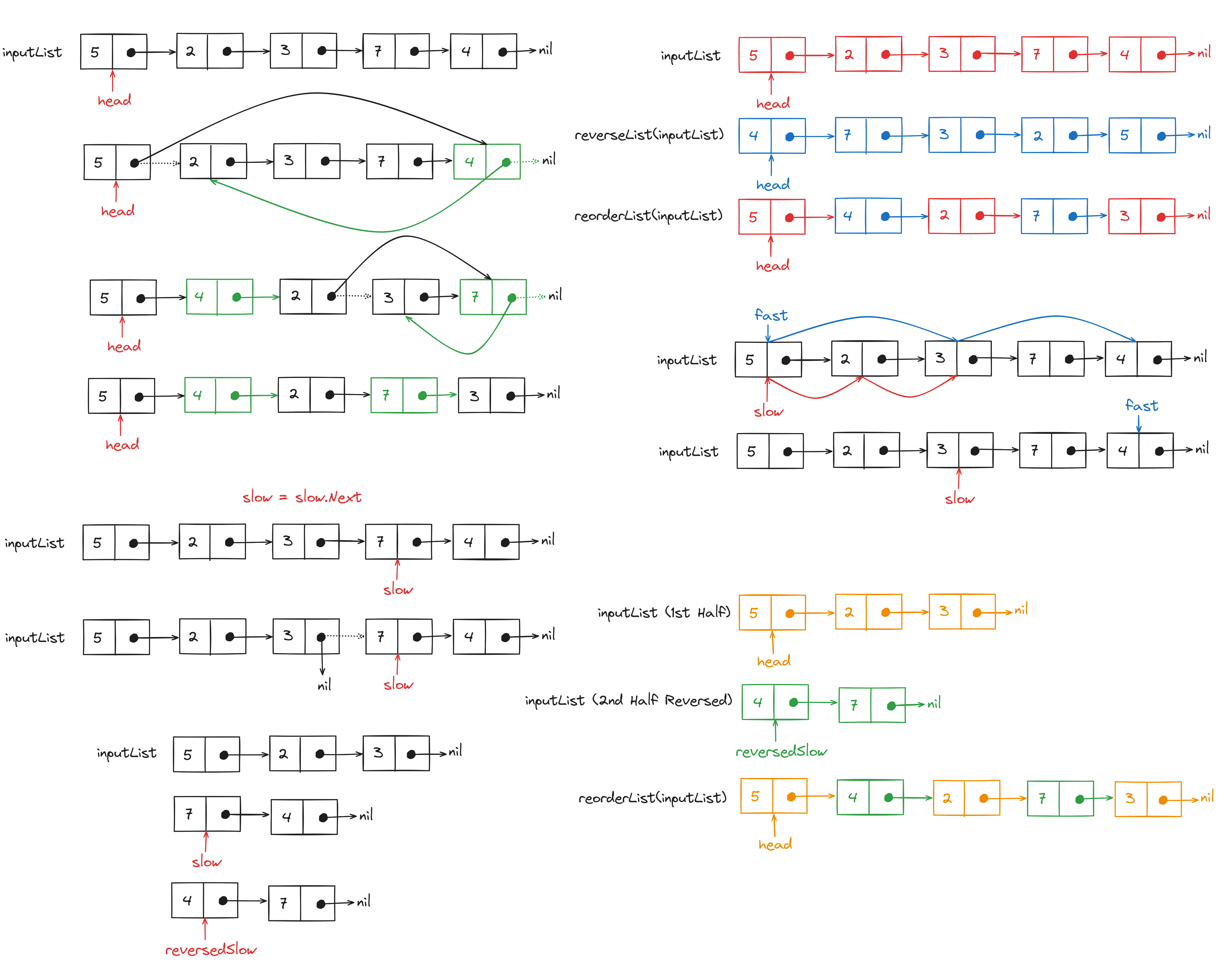Problem Statement
We have to implement the reorderList function that takes the head node of a linked list as input and reorders its
nodes in the format specified below.
Given an input list like the following:
$$Node_0 \rightarrow Node_1 \rightarrow Node_2 \rightarrow \dots \rightarrow Node_{(n-2)} \rightarrow Node_{(n-1)} \rightarrow Node_n$$
the reorderList function should reorder its nodes as:
$$Node_0 \rightarrow Node_n \rightarrow Node_1 \rightarrow Node_{(n-1)} \rightarrow Node_2 \rightarrow Node_{(n-2)} \rightarrow \dots$$
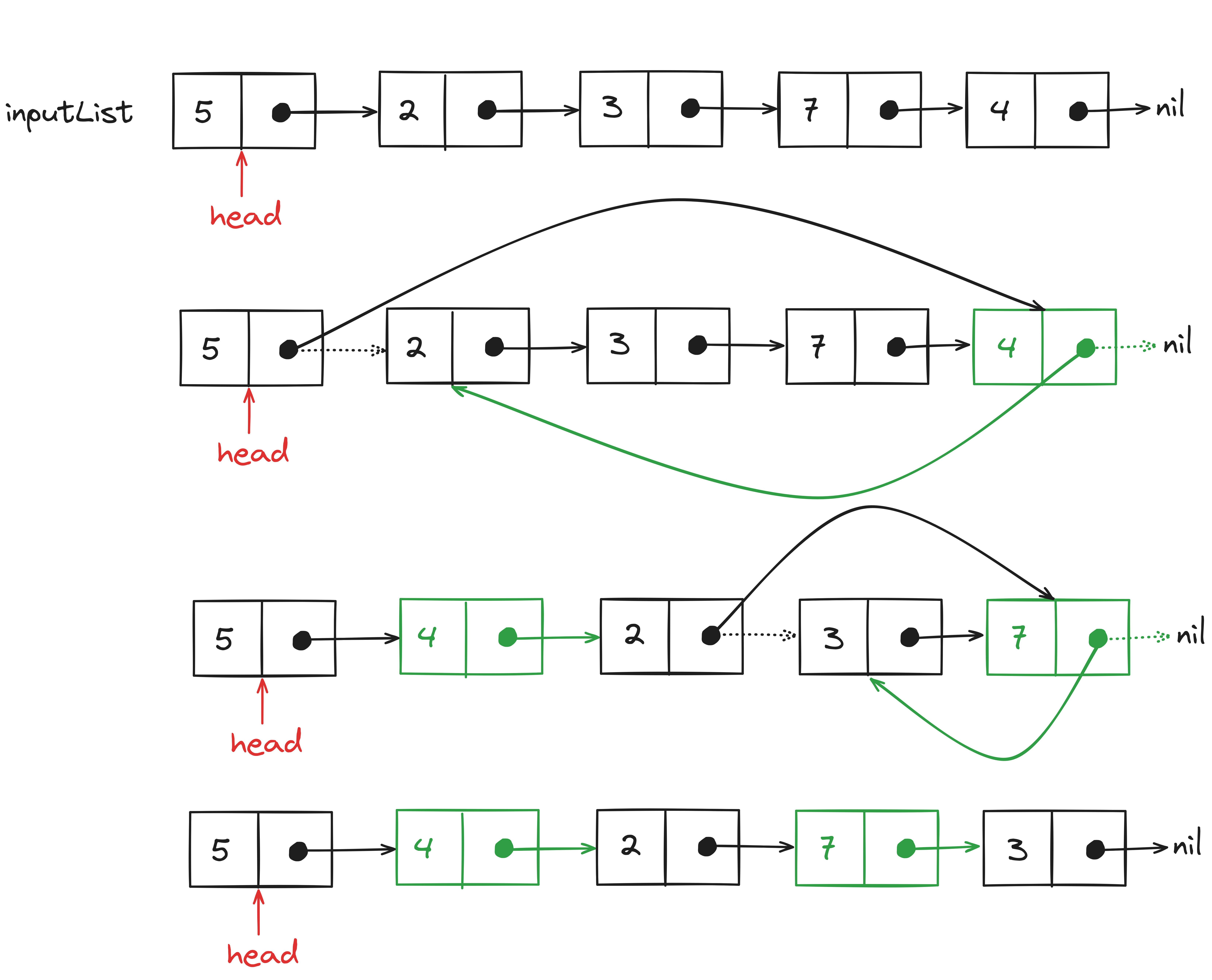
Brute Force Solution
To solve this problem we use two iterators: one starting from the head of the input list and another
starting from the head of the reversed input list.
We pick values alternatively from both iterators and create a new linked list. The loop will continue until the length of the length of the new linked list is equal to the length of the input list. The nodes in the new linked list will be ordered as specified in the problem statement.
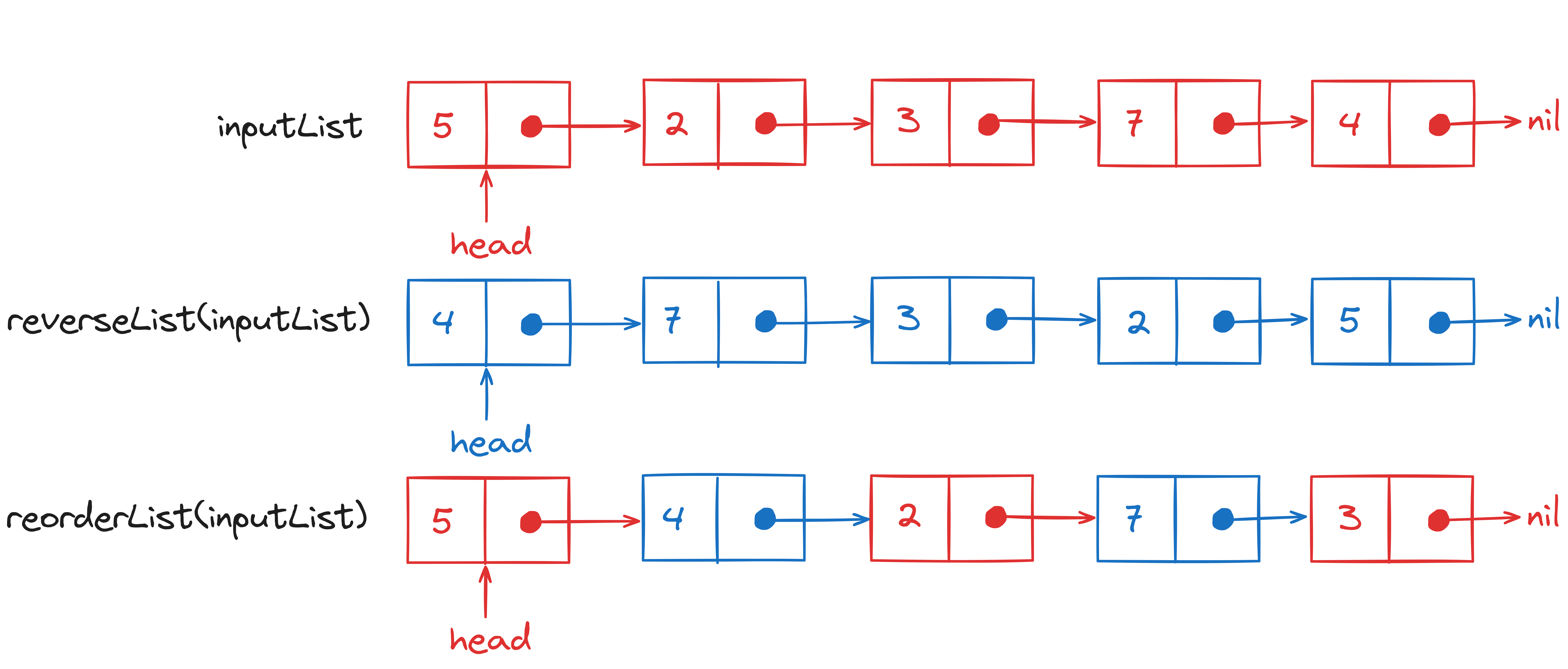
Psuedo-code for the Brute Force Solution
reversed_linked_list = reverseList(linked_list)
forward_iter = linked_list.head
reverse_iter = reversed_linked_list.head
reorderedLinkedList = LinkedList()
while(length(reorderedLinkedList)!=length(linked_list)){
reorderedLinkedList.insert(forward_iter)
if(length(reorderedLinkedList)==length(linked_list))
break
reorderedLinkedList.insert(reverse_iter)
if(length(reorderedLinkedList)==length(linked_list))
break
forward_iter=forward_iter.next
reversed_linked_list=reverse_iter.next
}
return reorderedLinkedList
Time Complexity Analysis
Best Case Scenario
With this brute-force solution, we have to iterate over the complete linked list, even in the best-case scenario.
The time complexity of the brute-force solution will be $O(n)$ (for iterating over the reorderedList) times
$O(n)$ (for calculating the current length of reorderedList) which will result in the total time complexity of $O(n^2)$.
Worst Case Scenario
The time complexity of the worst-case scenario will also be $O(n^2)$.
Space Complexity Analysis
The brute-force solution is using additional $O(2n)$ memory space to store the reversed and reordered linked list.
Code for Brute Force Solution
package main
import "fmt"
type ListNode struct {
Val int
Next *ListNode
}
func Display(ln *ListNode){
temp := ln
for(temp!=nil){
fmt.Printf("%d->", temp.Val)
temp=temp.Next
}
fmt.Println()
}
func Length(ln *ListNode)(int){
// Since this function iterates the complete linked list
// the time complexity of this function is O(n)
// where n is the length of the linked list
temp := ln
length := 0
for(temp!=nil){
length += 1
temp=temp.Next
}
return length
}
func insertAtFront(ln *ListNode, value int)(*ListNode){
// Time complexity of inserting a value at the head of the
// linked list is O(1)
newNode := &(ListNode{Val: value})
newNode.Next = ln
return newNode
}
func insertAtEnd(ln *ListNode, value int)(*ListNode){
// Time complexity of inserting a value at the end of the
// linked list is O(n)
if(ln==nil){
ln = &(ListNode{Val: value})
} else {
temp := ln
for(temp.Next!=nil){
temp = temp.Next
}
temp.Next = &(ListNode{Val: value})
}
return ln
}
func reverseList(ln *ListNode)(*ListNode){
// Time complexity of reversing a linked list is O(n)
// where n is the length of the linked list
var reversedList *ListNode
temp := ln
for(temp!=nil){
reversedList = insertAtFront(reversedList, temp.Val)
temp=temp.Next
}
return reversedList
}
func reorderList(head *ListNode){
forwardIter := head
reverseIter := reverseList(head)
inputListLength := Length(head)
var reorderedList *ListNode
// The following loop will be executed n times
// where n is the length of the linked list
for(Length(reorderedList)!=inputListLength){
// Inserting a value at the end of a linked list will take O(n) time
reorderedList = insertAtEnd(reorderedList, forwardIter.Val)
// Validating the length of a linked list will take O(n) time as well
if(Length(reorderedList)==inputListLength){
break
}
// Time Complexity: O(n)
reorderedList = insertAtEnd(reorderedList, reverseIter.Val)
// Time Complexity: O(n)
if(Length(reorderedList)==inputListLength){
break
}
forwardIter = forwardIter.Next
reverseIter = reverseIter.Next
}
// Copying the values of reorderedList to the input linked list
for(head!=nil){
head.Val = reorderedList.Val
head=head.Next
reorderedList=reorderedList.Next
}
}
func main(){
var ln *ListNode
ln = insertAtEnd(ln, 1)
ln = insertAtEnd(ln, 2)
ln = insertAtEnd(ln, 3)
ln = insertAtEnd(ln, 4)
ln = insertAtEnd(ln, 5)
fmt.Println("Input Linked List:")
Display(ln)
reorderList(ln)
fmt.Println("Reordered Linked List:")
Display(ln)
}
// Output
// Input Linked List:
// 1->2->3->4->5->
// Reordered Linked List:
// 1->5->2->4->3->
Optimized Solution
To solve this problem in linear time while also reducing the space complexity (by performing operations in-place) we have to switch to the Fast-Slow Pointer Approach.
We have to break the input linked list from the middle
(or the middle.Next node in the case of an odd number of nodes). Then we will insert the nodes from the second half of
the linked list in between the nodes of the first half. However, the second half of the linked list has to be reversed to
achieve the reordering format specified in the problem statement.
First, we will iterate over the input linked list using the fast and slow pointers.
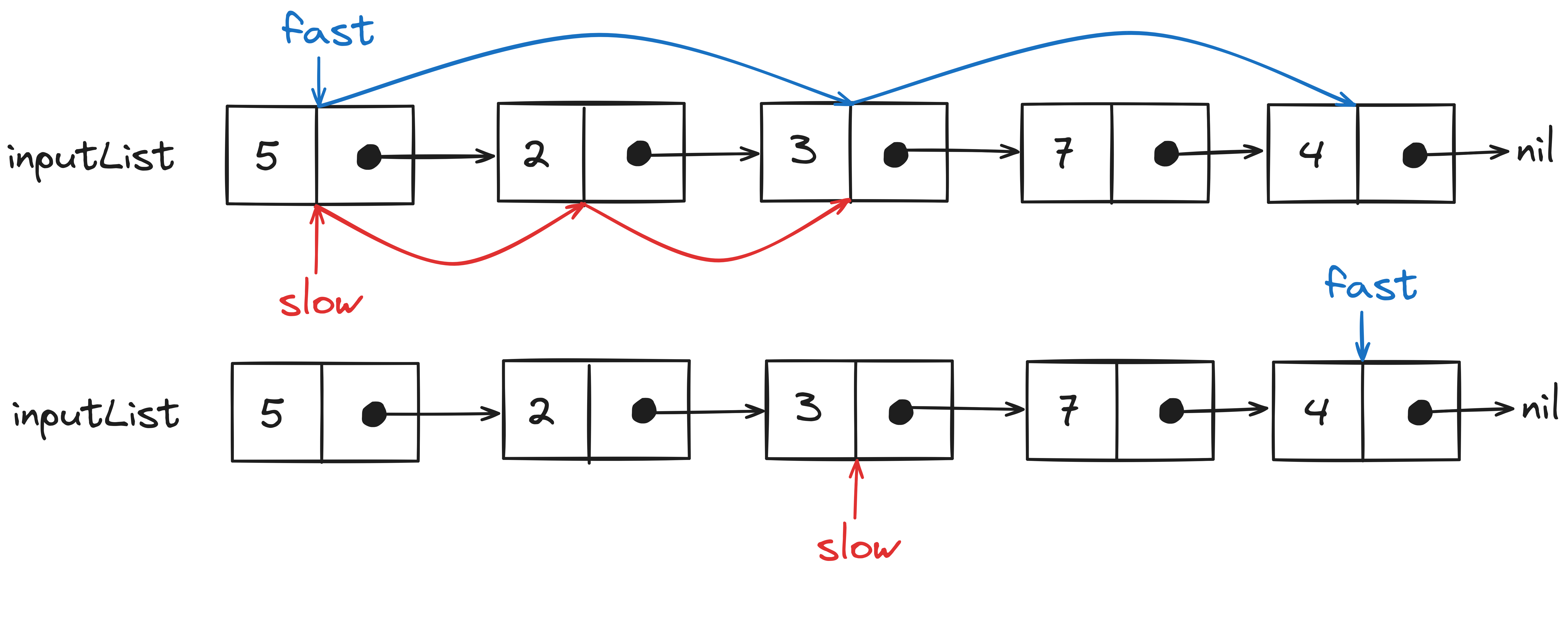
At the end of the iteration, the fast pointer will be at the end of the linked list and the slow pointer will be at
the middle node.
Then we will break the input linked list into two halves from the slow.Next node.
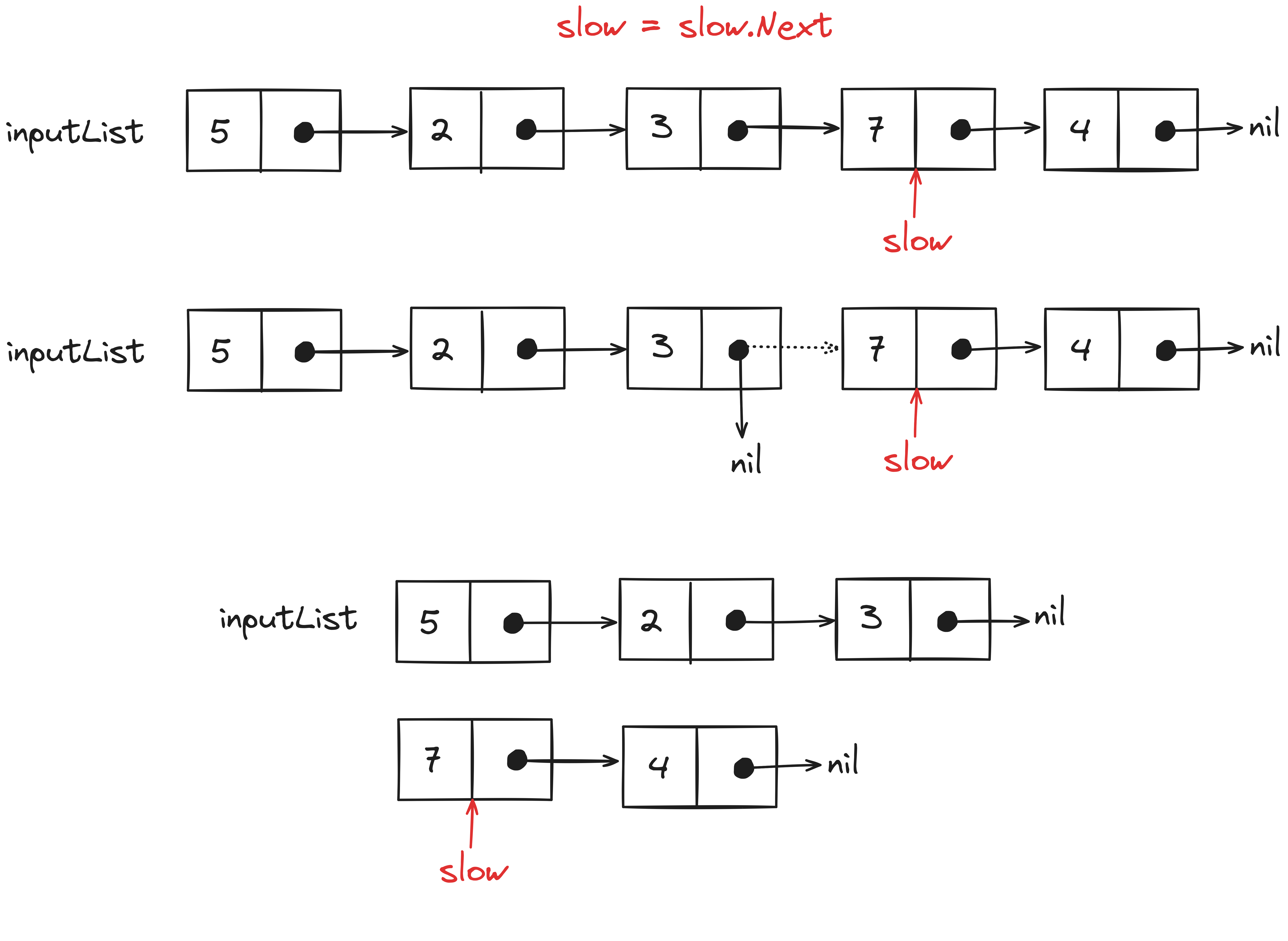
Since the reordering form requires the last node to be placed in between the first and second node of the list we have to reverse the second half of the input linked list.
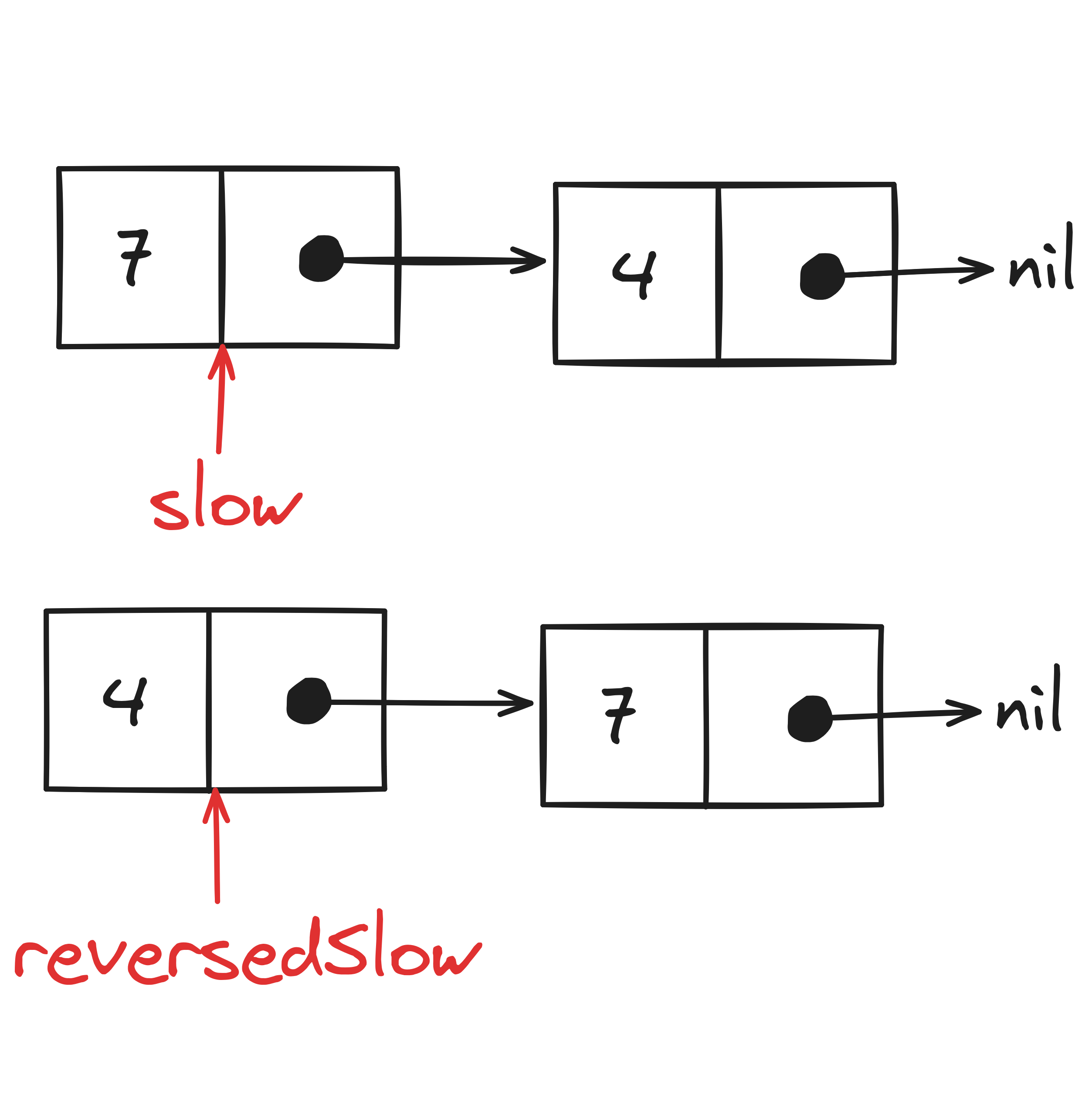
Finally, we will iterate over the first half of the input linked list while also inserting the nodes from the second half (reversed) in between.
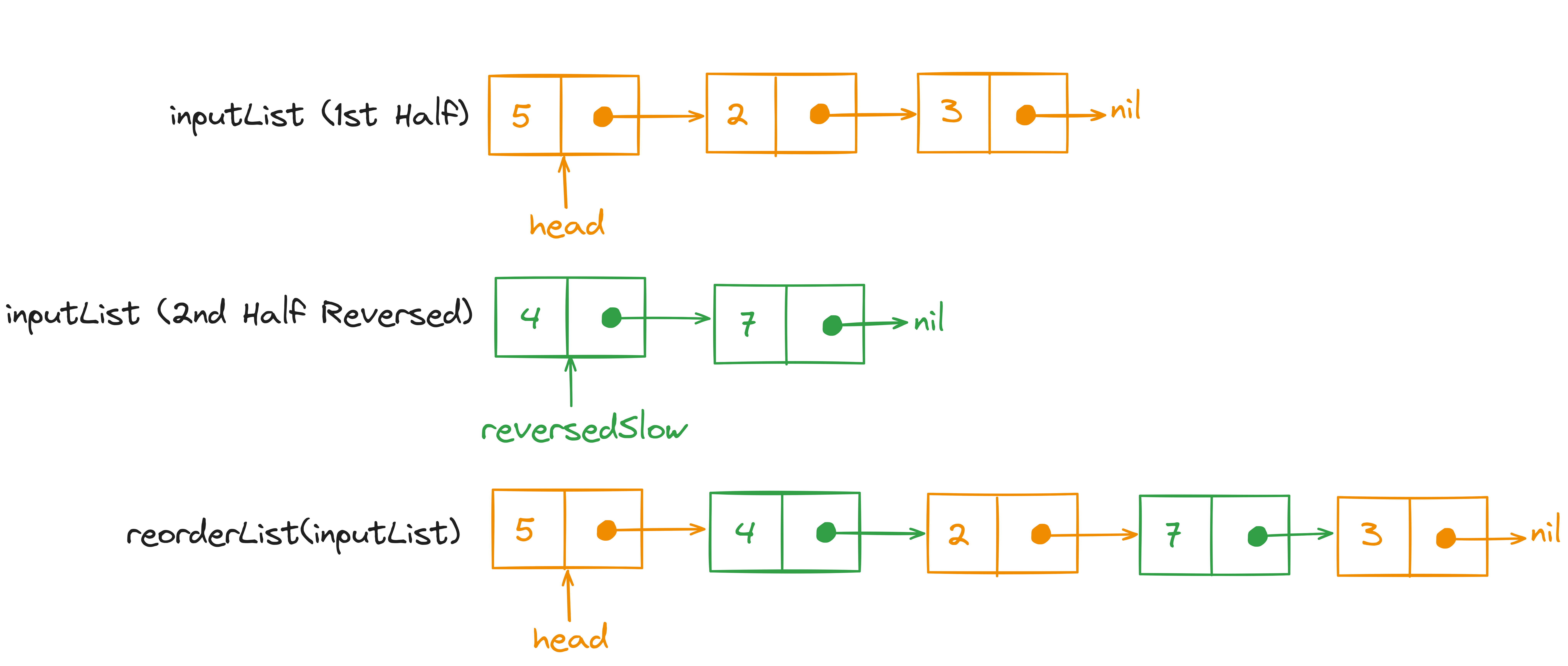
Psuedo code for the Optimized Solution
fast = linked_list.head
slow = linked_list.head
while(fast.next!=nil or fast!=nil){
fast = fast.next.next
slow = slow.next
}
temp = slow.next
slow.next = nil
slow = temp
reversed_half_list = reverse(slow)
temp = linked_list.head
reverse_temp = reversed_half_list.head
while(temp!=nil){
temp2 = temp.next
temp.next = reverse_temp
reverse_temp.next = temp2
temp = temp2
}
return linked_list.head
Time Complexity Analysis
Best Case Scenario
The time complexity of iterating over the input linked list using fast and slow pointers will be $O(n/2)$
(where $n$ is the size of the linked list) because the fast pointer will skip over every other node.
Reversing the second half of the input linked list will also take $O(n/2)$ time.
Since we are iterating over only the first half of the linked list in the last loop its time complexity will also be $O(n/2)$.
So the total time complexity of the optimized solution in the best-case scenario is $O(3n/2)$ which could be generalized to $O(n)$.
Worst Case Scenario
All the steps in the optimized solution will be executed regardless of the characteristics of the input linked list. So the time complexity for the worst-case scenario will also be $O(n)$.
Space Complexity Analysis
Since we are performing operations in place on the input linked list, no additional memory space is required by the optimized solution. Thus, the total space complexity of the optimized solution is $O(1)$.
Code for Optimized Solution
package main
import "fmt"
type ListNode struct {
Val int
Next *ListNode
}
func Display(ln *ListNode){
temp := ln
for(temp!=nil){
fmt.Printf("%d->", temp.Val)
temp = temp.Next
}
fmt.Println()
}
func insertAtFront(ln *ListNode, value int)(*ListNode){
newNode := &(ListNode{Val: value})
newNode.Next = ln
return newNode
}
func insertAtEnd(ln *ListNode, value int)(*ListNode){
if(ln==nil){
ln = &(ListNode{Val: value})
} else {
temp := ln
for(temp.Next!=nil){
temp=temp.Next
}
temp.Next = &(ListNode{Val: value})
}
return ln
}
func reverseList(ln *ListNode)(*ListNode){
var reverseList *ListNode
temp := ln
for(temp!=nil){
reverseList = insertAtFront(reverseList, temp.Val)
temp=temp.Next
}
return reverseList
}
func reorderList(head *ListNode){
// Iterating over the input linked list
// using the fast and slow pointer
// Time Complexity: O(n/2) since the fast pointer
// will skip over every other node
fast := head
slow := head
for(fast.Next!=nil){
if(fast.Next.Next!=nil){
// When the fast pointer finishes iteration
// the slow pointer will be at the middle node
fast = fast.Next.Next
slow = slow.Next
} else {
break
}
}
// Breaking the input linked list
// after the middle node
temp := slow.Next
slow.Next = nil
slow = temp
// Reversing the 2nd half of the linked list
// Time Complexity: O(n/2), where n is the size
// of the input linked list
reversedSecond := reverseList(slow)
// Iterating over the 1st half of the linked list
// and inserting nodes from the reversed 2nd half
// Time Complexity: O(n/2)
temp = head
for(reversedSecond!=nil){
// Storing next values of temp and reversedSecond
// in temporary variables
temp2 := temp.Next
tempReversedSlow := reversedSecond.Next
// Reassigning Next nodes of temp and reversedSecond
temp.Next = reversedSecond
reversedSecond.Next = temp2
temp = temp2
reversedSecond = tempReversedSlow
}
}
func main(){
var ln *ListNode
ln = insertAtEnd(ln, 1)
ln = insertAtEnd(ln, 2)
ln = insertAtEnd(ln, 3)
ln = insertAtEnd(ln, 4)
ln = insertAtEnd(ln, 5)
fmt.Println("Input Linked List:")
Display(ln)
reorderList(ln)
fmt.Println("Reordered Linked List:")
Display(ln)
}
// Output
// Input Linked List:
// 1->2->3->4->5->
// Reordered Linked List:
// 1->5->2->4->3->
Thank you for taking the time to read this blog post! If you found this content valuable and would like to stay updated with my latest posts consider subscribing to my RSS Feed.
Resources
143. Reorder List
Linkedin Interview Question - Reorder List - Leetcode 143 - Python
